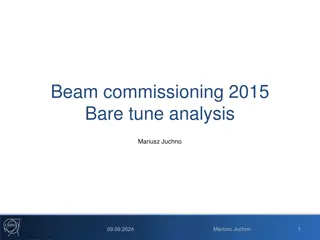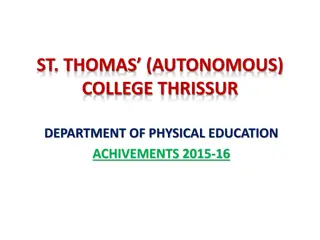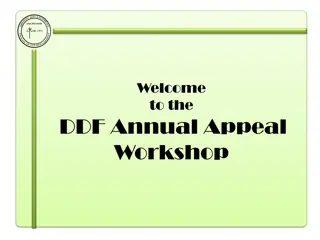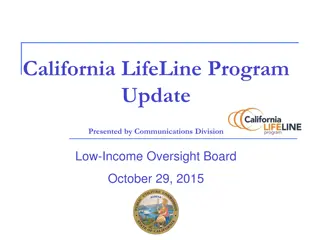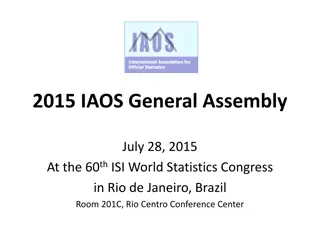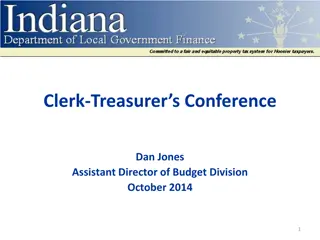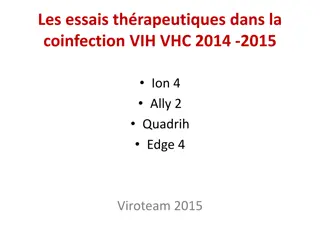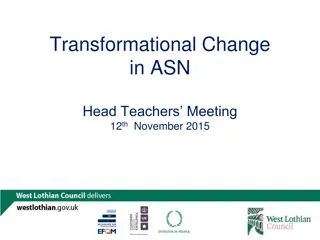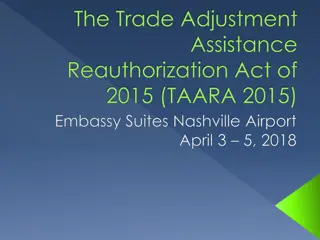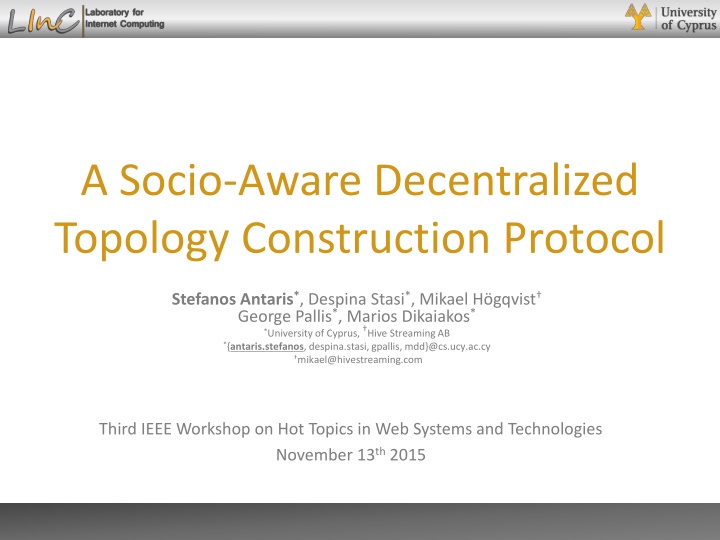
Decentralized Topology Construction Protocol for Social Networks
Discover a groundbreaking protocol designed by Stefanos Antaris and team at the University of Cyprus for constructing a decentralized topology leveraging social network structural properties to reduce network latency and number of hops in Distributed Online Social Networks (DOSNs). The research explores the integration of social graph data in Peer-to-Peer (P2P) connections, resulting in significant reductions in network latency and hops. For more insights, delve into their innovative methodology and findings shared at the Third IEEE Workshop on Hot Topics in Web Systems and Technologies.
Download Presentation

Please find below an Image/Link to download the presentation.
The content on the website is provided AS IS for your information and personal use only. It may not be sold, licensed, or shared on other websites without obtaining consent from the author. If you encounter any issues during the download, it is possible that the publisher has removed the file from their server.
You are allowed to download the files provided on this website for personal or commercial use, subject to the condition that they are used lawfully. All files are the property of their respective owners.
The content on the website is provided AS IS for your information and personal use only. It may not be sold, licensed, or shared on other websites without obtaining consent from the author.
E N D
Presentation Transcript
A Socio-Aware Decentralized Topology Construction Protocol Stefanos Antaris*, Despina Stasi*, Mikael H gqvist George Pallis*, Marios Dikaiakos* *University of Cyprus, Hive Streaming AB *{antaris.stefanos, despina.stasi, gpallis, mdd}@cs.ucy.ac.cy mikael@hivestreaming.com Third IEEE Workshop on Hot Topics in Web Systems and Technologies November 13th 2015 Stefanos Antaris
Introduction Ubiquitous communication platform Single server dependence Privacy issues Social Network Decentralization Reliability Data ownership Topology inconsistency Additional number of hops Network latency P2P Network Stefanos Antaris 2 13 November 2015, University of Cyprus
Research Question Is it possible to design a topology that incorporates the structural properties of the social network in order to reduce the number of hops and the network latency for a DOSN? Stefanos Antaris 3 13 November 2015, University of Cyprus
Contribution Design and implement a P2P Topology Construction Protocol Leverage the social graph for the P2P connections Apply on a real-life NewsFeed service Evaluate against state-of-the-art approaches 75% number of hops reduction 67% network latency reduction Stefanos Antaris 4 13 November 2015, University of Cyprus
Proposed Methodology Each social user participates as a peer in P2P overlay network Social Network Peer State NodeID 123 Social Neighbors IDs 112 134 101 P2P Network Routing Table 214 102 114 Stefanos Antaris 5 13 November 2015, University of Cyprus
Routing Table Construction Similar to Pastry[1] Why Pastry? Bounded number of TCP connections (N = 109, B = 16, #TCP = 105) Logarithmic number of hops prefix matching [2] Node failure-resilient Routing Table of Peer with NodeId 123 No digits in common 123 012 - 212 314 420 k = logN First digit in common 123 103 114 - 132 142 120 121 121 - 124 Two digits in common 123 [1] A. I. T. Rowstron and P. Druschel, Pastry: Scalable, decentralized object location, and routing for large-scale peer-to-peer systems ,Middleware 01 B-1 [2] C. G. Plaxton, et al., Accessing nearby copies of replicated objects in a distributed environment, IPDPS 09 Stefanos Antaris 6 13 November 2015, University of Cyprus
Routing Table Characteristics # peers eligible for a specific cell in the kthrow: N / Bk+1 More options on the first rows # social friends eligible for a specific cell in the kthrow: d / Bk+1 overlap with the Social connections is d / N The probability that P2P connections Routing Table of Peer with NodeId 123 No digits in common 123 012 - 212 314 420 k = logN First digit in common 123 103 114 - 132 142 120 121 121 - 124 Two digits in common 123 B-1 Stefanos Antaris 7 13 November 2015, University of Cyprus
Social Friendship Request Alice sends friend request to Bob Step 1 Bob and Alice still needs logN hops to communicate N=106 ,logN = 5 Social Network Peer 112 looks up peer 123 Step 2 Bob accepts friend request Step 3 Both update their Social Neighbors table P2P Network Step 4 Social Social Neighbors IDs Neighbors IDs 123 112 Stefanos Antaris 8 13 November 2015, University of Cyprus
NewsFeed Service Alice identifies Social Neighbors Node IDs Step 1 Social Neighbors IDs Social Network 123 NewsFeed service requires dlogN messages N=109 ,logN = 7 d = 3000, # of messages = 21000 334 Alice sends message to Bob Step 2 Alice sends message to Trudy P2P Network Step 3 Stefanos Antaris 9 13 November 2015, University of Cyprus
Socially-aware Routing Table (1/3) Desired properties Bounded number of TCP connections Maximize the direct connections between social friends Communication between non-social friends in logNhops Bob s Peer State Can we augment the Social Neighbors IDs in the Routing Table? Routing Table of Peer with NodeId 123 Social Neighbors IDs 012 - 212 314 420 112 103 114 - 132 142 220 120 121 121 - 124 113 Stefanos Antaris 10 13 November 2015, University of Cyprus
Socially-aware Routing Table (2/3) Step 1 : Periodically check for updates in Social Neighbors IDs table Step 2 : New social friend is added Step 3 : Identify appropriate position in Routing Table - Similar to Pastry Step 4 : Replace previous connection Bob s Peer State Routing Table of Peer with NodeId 123 Social Neighbors IDs 012 - 212 314 420 220 103 114 - 132 142 Conflict. Which one is the best candidate? 112 120 121 121 - 124 113 Stefanos Antaris 11 13 November 2015, University of Cyprus
Socially-aware Routing Table (3/3) Conflict solution Compare network latencies t(123,112) > t(123,113) Choose minimum Achievements Biased flavor on the friends Reduce the data propagation latency Bob s Peer State Routing Table of Peer with NodeId 123 Social Neighbors IDs 012 - 212 314 420 220 103 114 - 132 142 112 120 121 121 - 124 113 Stefanos Antaris 12 13 November 2015, University of Cyprus
Evaluation Data Set Users Connections Average Degree Facebook [1] 63,731 817,090 25.642 Twitter [2] 456,631 14,855,874 32.533 Slashdot [2] 82,168 948,463 11.543 Epinions [2] 75,879 508,837 6.706 NewsFeed simulation: Data generation rate: exponential distribution [3] Information diffusion: users propagate their posts to their social friends independently Simulation parameters: Data Sets with different characteristics Node registration rate: exponential distribution [3] Number of trials: 100 independent simulations Discrete event simulator: FreePastry 2.1 [1] B. Viswanath, et al., On the evolution of user interaction in facebook , WOSN, 2009 [2] Stanford large network dataset collection , http://snap.stanford.edu, accessed Jul. 02, 2015 [3]K. Zhu, et al., Modelling population growth in online social networks , Complex Adaptive Modelling, 2013 Stefanos Antaris 13 13 November 2015, University of Cyprus
Evaluation Data Set Users Connections Average Degree Facebook [1] 63,731 817,090 25.642 Twitter [2] 456,631 14,855,874 32.533 Slashdot [2] 82,168 948,463 11.543 Epinions [2] 75,879 508,837 6.706 Evaluation metrics used: Number of Hops: The P2P hops required to communicate two social friends Network Latency: The time spent to propagate a message % of social connections: The social connections coverage State-Of-The-Art comparison: Pastry: No social friendship augmentation SPROUT [3]: Chord overlay network with additional social connections [1] B. Viswanath, et al., On the evolution of user interaction in facebook , WOSN, 2009 [2] Stanford large network dataset collection , http://snap.stanford.edu, accessed Jul. 02, 2015 [3] S. Marti, P. Ganesan, and H. Garcia-Molina, DHT routing using social links , P2P, 2004 Stefanos Antaris 14 13 November 2015, University of Cyprus
Percentage of Social Connections More than 60% of social friends are included in the routing table. grows Routing Table Size logN (B-1) user s neighborhood set. Unrealistic for real- life social networks Social friendship coverage increases as the network results Direct connections to all of the social SPROUT achieves better Av. Degree: 6.706 Nodes: 75,879 Av. Degree: 25.642 Nodes: 63,731 Av. Degree: 11.543 Nodes: 82,168 Av. Degree 32.533 Nodes: 456,631 Stefanos Antaris 15 13 November 2015, University of Cyprus
Number of Hops 75% hops reduction in all Data Sets Hops are not increasing logarithmically as the network grows Stefanos Antaris 16 13 November 2015, University of Cyprus
Network Latency 67% network latency reduction SPROUT Depends on the connectivity between social friends. Stefanos Antaris 17 13 November 2015, University of Cyprus
Conclusions Socially-aware P2P overlay network Bounded number of P2P connections 60% more socially-connected peers Random lookups in hops NewsFeed service Information propagation with 75% less hops Network latency reduced by 67% Future research questions Biased Node ID assignment? Routing using social network subgraph? Social users interactions? logN Stefanos Antaris 18 13 November 2015, University of Cyprus
Acknowledgements isocial-itn.eu co-funded by the European Commission Stefanos Antaris 10 March 2015, University of Cyprus
antaris.stefanos@cs.ucy.ac.cy http://cs.ucy.ac.cy/~santar01 Laboratory for Internet Computing Department of Computer Science University of Cyprus http://linc.ucy.ac.cy Stefanos Antaris 20 13 November 2015, University of Cyprus



